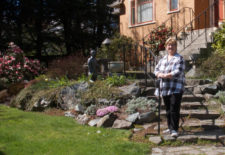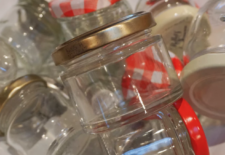Shoal Harbour: Making Birds Feel at Home
by Sue Stroud, citizen reporter
Nestled between marinas on the downtown Sidney waterfront you’ll find one of the Peninsula’s best-kept and enchanting secrets, Shoal Harbour Migratory Bird Sanctuary.
The sanctuary was founded in 1931 and is one of the oldest migratory bird sanctuaries in Canada along with its sisters Victoria Harbour Migratory Bird Sanctuary (1923) and Esquimalt Migratory Bird Sanctuary (1931).
“The Bufflehead ducks are like the famous swallows of San Capistrano.”
~ Sue Staniford, FOSH
This year marks the centennial of the convention between Canada and the United States for the protection of migratory birds and Saanich Voice Online caught up with busy co-founders of the Friends of Shoal Harbour (FOSH), Sue Staniforth and resident biologist Kerry Finley, to find out more about this local gem.
The Canada-United States Migratory Birds Convention came about when it was noticed that bird populations were declining as a result of habitat destruction, and fashion and food consumption. There were no regulations in place to limit kills or protect fragile habitats at the time so Canada and the US came together to create the regulations needed. Over the years Mexico, Japan and Russia have all joined in this collaboration.
See the Hinterland video HERE.
Migratory bird sanctuaries like Shoal Harbour may be lovely places to walk and meditate, and there is so much more going on.
You’ll find a demonstration garden of native plants at Roberts Bay cultivated by the Tseycum First Nation and a local native plant group. Local elementary and secondary school students learn about native and invasive plant species as they help keep the sanctuary free of invasive species and do habitat and species mapping, and local plein-air painters like Farrell Boyce and photographers like Suzanne Huot use the space for inspiration.
And, if you’re lucky, you might find Finley counting Bufflehead ducks and recording changes in their migration patterns as they return from their favoured summer feeding and breeding grounds in the interior of BC. “This is my 20th year of continuous monitoring and the 17th year I have followed them from their breeding sites to the sanctuary,” explains Finley.
Keeping the sanctuary safe is an unending task. There are four marinas in and about the sanctuary and although in practice they are fairly green, occasionally someone will bring up the subject of dredging. “The pressure to dredge for additional marina space is enormous,” says Staniforth who serves as the chair of FOSH. She goes on to explain that such activity would kill the mud shrimp and the tiny green zooplankton, which make up part of the 63 species of birds’ diets. Housing developers have shown interest in expanding into more fragile areas, taking down trees and thus reducing nesting areas and driving away the insects that the birds feed on.
While you might think oil spills from the marinas would be the most serious concern, it’s actually run-off from the land with its garden fertilizers, pesticides, and building waste that is a more frequent problem. A spill entering the ocean from Mermaid Creek was traced to a household perimeter drain, doing serious damage in 2012. This spill served to alert local municipalities who erected signs to encourage the immediate reporting of spills in any of the local creeks.
Local conservation and stewardship groups such as FOSH, Peninsula Streams, Shorekeepers and Habitat Acquisition Trust work with all levels of government to protect the area and to garner funds for needed ongoing water quality testing. But if you ask Staniforth about the best way to protect the sanctuary she’ll tell you it’s outreach. “You have to reach the people, let them know it’s there, teach them what its function is. We try to do this through inspiring and celebratory events like All Buffleheads Day, the kayak tour this past spring and The Great Canadian Shore Cleanup. Getting people involved is the key.”
“The Bufflehead ducks,” Staniford says, “are like the famous swallows of San Capistrano. They have always returned on the same day – October 15 – which is the 298th day of the year, so we celebrate their return. They are the smallest diving ducks, but they have the biggest feet and they like to nest in woodpecker holes.” Staniford is a marine biologist who was studying large marine mammals when she became part of the Citizens Coalition for Conservation group, which morphed into the FOSH.
A new initiative is underway called the Urban Sanctuaries Project, a promotional project initiated by FOSH and supported by the Robert Bateman Centre, Nature Canada and Jacques Sirois of the Victoria Harbour Migratory Bird Sanctuary. “The public is definitely more aware of the sanctuaries, but as new people arrive we have to keep that interest growing, we have to increase awareness of what local habitats mean to migratory birds,” says Finley.
“We are also working with UVic Environmental Law Centre on creating new legislation regarding development along the waterfront. This involves many overlapping jurisdictions that govern such diverse things as federal airspace and wildlife trees. We’ll be trying to help Environment Canada live up to our environmental standards,” explains Finley.
“The other thing that is not often mentioned are the social and health benefits that people derive from having wildlife and wildlife habitat surrounding them, and in this we are deeply blessed,” says Finley. He’ll tell you that what inspires him most is the fact that you can walk off a BC Ferry and be right in the heart of some of the rarest bird ecosystems on the planet.
Shoal Harbour Migratory Bird Sanctuary encompasses 150 hectares of coastal marine environment. The stunning array of wildlife that it serves safe harbour to are probably best viewed from the nearby Resthaven Park. The next time you go for a walk in the naturehood give some thought to the effort and dedication behind this magnificent treasure. You might even consider contacting the Friends of Shoal Harbour, attend one of their meetings and lend your support.
And if you’re really lucky on your next visit, you might even see an eagle take an old merganser – for lunch.


